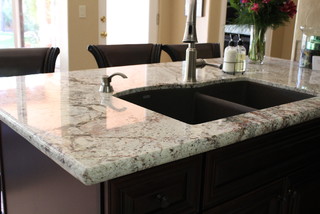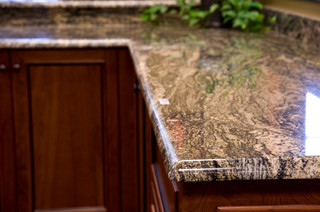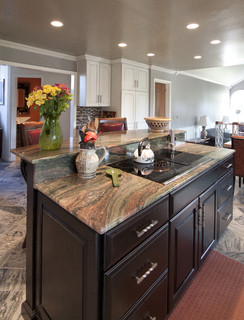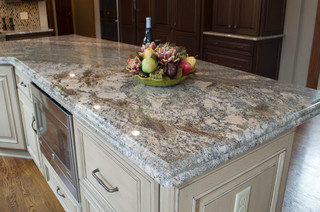Welcome to AccuGlide’s Start-Up Guides! Our first guide goes into one of the most valuable lessons for a stone shop: What edge profiles should I offer? And what are the best practices for shaping and polishing?
Which Edge Profiles Should I Offer?
Edge profiles vary from region to region, so you may have a few profiles in mind that your clients are asking for. If you do not have a clear idea of what your clients want, you can go with what’s popular nationwide. You may want to suggest profiles that are both popular and are the least labor intensive to produce.
Below are two groups of profiles, organized by popularity. Right now the clean, simple basic profiles of Group 1 are “in” – which is great for you! You can hold off on stocking diamond tooling for Group 2 until you receive a client request. But don’t shy away from offering these profiles on your website and showroom if appropriate.
Group 1 Profiles: Modern & Contemporary
Eased
- Flat polish
- 1/16” to 1/4” top round
- Slight break on the bottom corner
Bevel
- Flat polish
- Bevel ranging from 1/16” 3/4” (most common is 1/4” bevel on top) Slight break on the bottom corner.
Crescent / Pencil / Panoramic
- A soft rounded profile without the dated look of a bullnose
Group 2 Profiles: The Classics
Bullnose
- Full round on top
- Slight break on the bottom corner
Demi Bullnose
- Generous round on top at least 1/2 of the thickness of the material
- Transitions to a flat face
- Slight break on the bottom corner
Full (Double) Bullnose
- Symmetrical bullnose on top and bottom
Ogee
- Cove round on the top
- Transitions to half bullnose
- Slight break on the bottom corner
Ogee Over Bullnose
- Ogee shape with added bullnose on the bottom
Triple Waterfall
- Three small bullnoses layered/staggered in a waterfall shape
- Slight break on the bottom corner
What are the best practices for shaping and polishing?
Shaping and polishing are very important quality control steps in a shop. The edges you offer your clients need to be consistent no matter who is shaping in the shop that day.
Using the Right Tools
One of the first questions you may have is “Should we shape with manual hand tools, a router, or a larger machine?” Good question, as it impacts not only the quality and speed of your work, but how much you invest in equipment.
If your workers have a lot of skill and experience, you can get away with shaping edges with hand tools. If your workers are less experienced, it’s better to go with a stone router and diamond bits.
Picking the Right Bits
Next you’ll need to know what router bits to shape with before polishing. If you are shaping edge profiles that range from 1/8″ to 1/4” you can cheat a bit and use a router bit position 1 only. Shape profiles that range from 1/4″ to 1/2” with both positions 1 and 2.
For deeper profiles (over 1/2”), and all profiles found in Group 2, use at least three router positions. These are also known as pos 0, pos 1, and pos 2. Each position will build on the other. For example, pos 0 is the “edge break” position; pos 1 is the “profiling” position; and pos 2 is the “finishing” position. As your worker’s skill increases, they may drop pos 2 for example, but they’ll never drop pos 0.
TIP:
For profiles in Group 2 as well as the “Crescent” edge, don’t cheat! Always start with the lowest position available. Why? Because if you skip position 0 on these deeper profiles, you will damage positions 1 and 2 tooling. Any “time saved” will result in increased cost and edge shape inconsistency.
Having a Polishing Procedure
After shaping you’ll want to establish a polishing procedure in your shop. This will give your company an important consistency advantage. This polishing procedure may vary from profile to profile.
With less experienced workers, take profiles all the way to position 2 on the router. Following position 2, the polisher can start with a 200 grit diamond wet pad. It’s very difficult to change the shape of a routered profile shape with 200 grit diamond pad.
With more skilled workers, profiling can stop at pos 0 or 1, then start sanding/polishing at grit 50 or 100. These lower grit diamond pads are for shaping rather than polishing. So be aware that you may lose your consistent edges if an unpracticed worker uses this procedure.
There are two ways to polish Group 2 profiles. The profiles with internal curves or corners are the most complicated to polish. A skilled fabricator can (with some difficulty) polish these. But we recommend a full 7-step CNC style set of diamond router tooling for better results.
Personalized One-on-One Help
We can help you figure out what tools you need and what profiles to offer. Shoot an email to ben@accuglidesaws.com or comment below and tell us how many jobs per week you’re going to take on. This will help us determine how fast you will want to grow from manual to router to larger machine.









